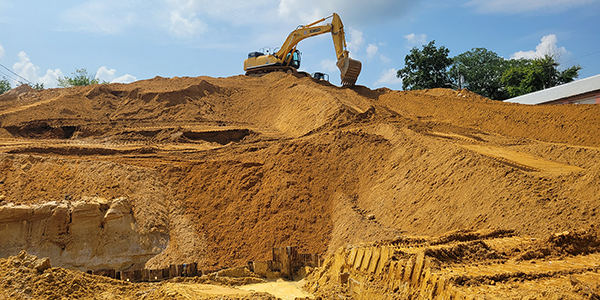
16 May VIDEO: DPW Cleanup Combines Old-School Remedial Techniques with High-Tech Bioremediation
Reading Time: 3 minutesProject Overview
ESA was retained by a south Jersey municipality to decommission and remove fuel oil and gasoline underground storage tanks (USTs) located at their Department of Public Works (DPW) facility. The municipality installed these USTs in the 1960s to fuel vehicles, equipment, and boiler units located within various buildings, including a former maintenance garage. Upon removal, most of the USTs were leaking, causing extensive soil and groundwater contamination. Site geology consisted of unconsolidated sand, gravel, and scattered clay lenses.
ESA performed a strategic remedial investigation to delineate source soil contamination and the impacted groundwater plume, which was determined to extend up to a quarter-mile downgradient and offsite. Petroleum-impacted groundwater had migrated down to 75 feet below the ground surface in the contamination source area. The horizontal and vertical extent of the impacted groundwater plume was exacerbated by a downgradient municipal supply well, which was decommissioned upon identifying the groundwater contamination. To fulfill New Jersey Department of Environmental Protection (NJDEP) requirements, ESA completed the remedial investigation and delineation of petroleum impacted soil and groundwater, performed soil-gas/vapor surveys of adjacent properties, conducted ecological evaluations, and implemented interim remedial measures. After thorough evaluation of multiple technologies and methods to remediate the soil and groundwater contamination, ESA developed a remedial workplan to address the impacted environmental media and cost-efficiently achieve the municipality’s long-term goals for the property.
Challenges
Prior to beginning this complex remedial workplan, ESA coordinated with state, county, and municipal entities, including the New Jersey Department of Environmental Protection (NJDEP), the County Bureau of Soil Erosion and Sediment Control, and several municipal departments including engineering, public works, traffic, education, and police. ESA worked closely with engineering, public works, and both municipal electrical and water utility departments to ensure operational and utility access onsite throughout the project.
Additional challenges existed due to the scattered presence of multiple sources of soil contamination. Localized pockets of petroleum-impacted soil were present at various locations on site. Moreover, soil impacts were found from five to 30 feet below ground surface, many of which were below the groundwater table. ESA needed to quickly and cost effectively address these soil impacts. Simultaneously, ESA needed to remediate the groundwater within the excavation, opting to use a bioremedial direct-contact method. To meet these dual objectives, the excavation required an engineered steel shoring system installed 20 to 35 feet below the ground surface, as well as an extensive dewatering system, followed by on-site treatment prior to discharge to the local water treatment authority.
Solution
Various factors were considered in the development of a strategic remediation plan, including site characteristics, projected costs, and long-term property-use plans. A multi-stage remedial approach was executed that included excavation, transport, and disposal of contaminated soil. Groundwater on site also required treatment. ESA opted for a direct contact, bio-remedial groundwater polishing technique conducted with the approval of NJDEP. Bioremediation was accomplished by inoculating the groundwater 25 to 35 feet below ground surface with bacteria and an enzyme that provided both oxygen and nutrients.
Due to the nature of the property and its unconsolidated (and at times physically unstable) geology, ESA coordinated the soil excavation and bioremedial groundwater polishing activities with highly specialized subcontractors and municipal departments to keep the DPW fully operational during all remedial activities. Because of the depth of the overall excavation in the unconsolidated geology, steel pilings were driven into the ground at the base of the open excavation at approximately 20 feet below ground surface using a vibratory hammer. The open excavation area was then segregated into six cells at the groundwater interface. After the steel sheets were installed and a cell was completed, the contaminated soil was excavated to depth, followed by inoculation of the bioremedial solution. ESA used more than 2,000 pounds of the custom blended bioremedial bacteria/enzyme/nutrient mixture.
In all, ESA disposed of 1,600 truckloads of petroleum-contaminated soil, restored the property to existing grade, and returned the site to full operation in under four months. Following the source area remediation and restoration activities, an extensive monitoring well network was reinstalled to conduct groundwater monitoring and compliance sampling activities to determine the effectiveness of Monitored Natural Attenuation (MNA) for the groundwater.
Outcome
Post-excavation soil sampling confirmed that sufficient petroleum contaminated soil was removed to comply with NJDEP Technical Requirements for Site Remediation and the Municipality’s long-term property use goals. As anticipated, recent groundwater sampling results indicate decreasing concentrations of the dissolved phase contamination. The extent of groundwater contamination has reduced from over a quarter mile offsite to within the property boundary. ESA prepared a comprehensive soil remedial investigation and remedial action report for submittal to the NJDEP. Throughout the project, ESA worked diligently to minimize change orders and overall remedial costs. This property is currently undergoing redevelopment for continued use as the municipal DPW and the depot to fuel municipal vehicles. The new DPW will be more efficient, safer, and environmentally compliant.



